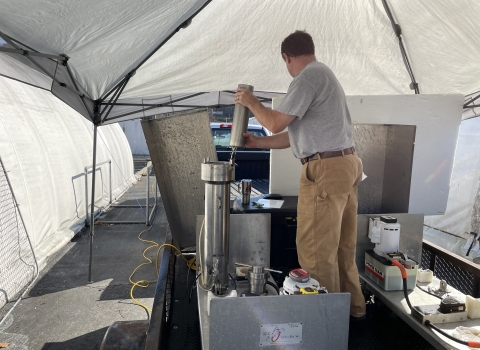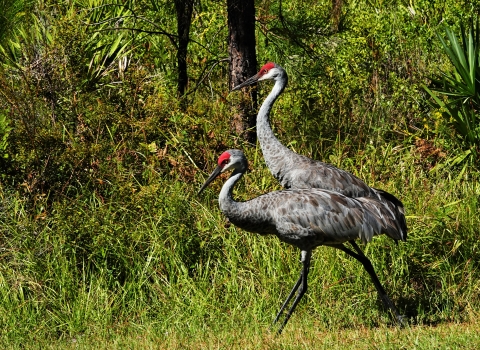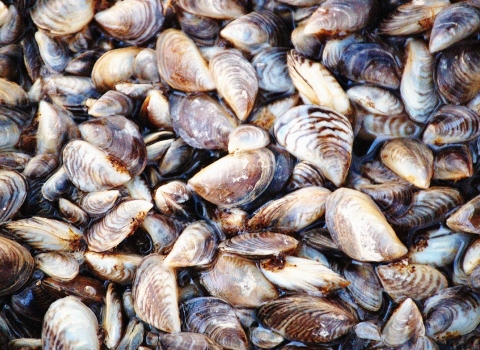The Olympic Peninsula in southern Washington is home to breathtaking beauty and a variety of ecosystems. Foggy temperate rainforests, brilliant glacier-capped mountains, diverse beaches and tidal zones, and interconnected lakes and rivers provide sanctuary for an extraordinary number of species. Anchoring the peninsula is the Elwha River, 45 miles of riverine ecosystem that has provided Indigenous people sustenance for thousands of years.
Today, the Lower Elwha Klallam Tribe of Washington, federal and state agencies, and other partners are working hard to restore the Elwha River drainage after the removal of two dams. The Pacific lamprey, a historically significant Tribal species, is a cornerstone of the restoration effort.
“The lamprey were a source of food for our Tribal members,” says Russ Hepfer, vice chairman of the Lower Elwha Klallam Tribe. “I would like to see it reintroduced as a food source.”
mong Tribes, food, such as the lamprey, is more than a resource. In many Tribal histories, plants and animals gave of themselves to sustain human life. Villages, lifeways, languages, religions, and cultures were built around and upon them. The very identity of a people is intertwined with the foods that they gathered, harvested, shared, and consumed. Respect for these resources is tantamount to respect for life.
In negotiating treaties, it was no mistake that Tribes specifically reserved hunting, fishing, and gathering at usual and accustomed places — doing so was necessary for continued existence and an expression of Tribal sovereignty. It is amazing to realize that Tribal leaders could see ahead 150 years ago to these future needs of their people.
Why Lamprey Matter
Long before dinosaurs appeared on the scene, lamprey inhabited our planet. Older than trees, these jawless fishes first appeared in the fossil record about 400 million years ago. With approximately 44 species, lamprey are found all over the world in fresh and salt water. Fourteen of these lamprey species are native to the West Coast of the United States. In the Northwest, Pacific lamprey play a vital role in determining ecosystem health and provide a valuable first food for Indigenous people.
Historic Dam Removals
Between 1911 and 1927, private financiers built the Elwha Dam and Glines Canyon Dam to provide power to the Olympic Peninsula and community of Port Angeles, Washington. These dams blocked anadromous fish from accessing 90% of the watershed and degraded downstream habitat by blocking the delivery of sediment and woody debris.
Anadromous fish, such as Pacific lamprey, spend most of their adult lives at sea but return to fresh water to spawn.
After decades of work by the Lower Elwha Klallam Tribe and others, Congress passed the Elwha River Ecosystem and Fisheries Restoration Act in 1992 to restore habitat and allow anadromous fish to return to the watershed. Between 2011 and 2014, both dams were removed, completing the biggest dam removals in history and starting the process of restoring the river ecosystem. Restoration can be a lengthy process, and there are many methods of measuring the degree of an ecosystem’s resilience. The lamprey, an ancient, often misunderstood fish, provides one of those meaningful measurements.
Emerging Threats
Despite current efforts to conserve Pacific lamprey, threats continue to emerge. Although Pacific lamprey were historically widespread along the west coast of North America, their abundance is declining, and their distribution is contracting throughout Oregon, Washington, Idaho, and California. Threats to Pacific lamprey occur throughout much of the range of the species and include: restricted fish passage fish passage
Fish passage is the ability of fish or other aquatic species to move freely throughout their life to find food, reproduce, and complete their natural migration cycles. Millions of barriers to fish passage across the country are fragmenting habitat and leading to species declines. The U.S. Fish and Wildlife Service's National Fish Passage Program is working to reconnect watersheds to benefit both wildlife and people.
Learn more about fish passage , reduced water flow, loss of streams, habitat degradation, degraded water quality, and changing marine and climate conditions. These threats, in conjunction with declining distribution and depressed abundance, affect the status of lamprey.
Climate Change
We also know that climate change climate change
Climate change includes both global warming driven by human-induced emissions of greenhouse gases and the resulting large-scale shifts in weather patterns. Though there have been previous periods of climatic change, since the mid-20th century humans have had an unprecedented impact on Earth's climate system and caused change on a global scale.
Learn more about climate change poses a threat to lamprey, too, but don’t yet know what it means for the future of these fish. Resident species of lamprey are especially at risk in a changing climate because they cannot migrate to cooler waters. Warming temperatures, changes in precipitation, and altered water flow may be especially problematic for southern species of lamprey, but lamprey species in the Northwest face passage impediments and the loss of habitat, making them also vulnerable to climate change.
If rearing and spawning habitats become unavailable to lamprey due to changing temperatures, reduced water availability, or extreme events, the communities that depend on lamprey could also be at risk.
Restoring the Ecosystem
Funding for these restoration efforts has come from a number of sources, including the Service’s Tribal Wildlife Grants (TWG). The purpose of TWG is to provide a competitive funding opportunity to federally recognized Tribal governments for the development and implementation of programs that benefit fish and wildlife resources and their habitat. Tribes apply TWG awards, administered by the Service’s Wildlife and Sport Fish Restoration Program, toward a variety of projects including restoration of habitats and species of cultural importance.
In the Columbia-Pacific Northwest Region, besides the Elwha River work, TWG funds have been used to: restore bighorn sheep populations along the Salmon River in Idaho with the Nez Perce Tribe; restore shrub-steppe species on the Yakama Indian Reservation with the Yakama Nation; employ beavers to restore ecosystem functions in the Snohomish watershed with the Tulalip Tribes; and conserve Pacific lamprey in the Tenmile Lakes Basin with the Confederated Tribes of Coos, Lower Umpqua, and Siuslaw Indians.
While the objective of TWG is to develop and implement programs that benefit fish and wildlife resources and their habitat, these projects often support Environmental Justice objectives as well.
Environmental Justice and Ecological Restoration
Much of the conservation work of Tribes today, such as that of the Lower Elwha Klallam Tribe to remove the Elwha Dams and restore the ecosystem of the Elwha River, is as much about the protection of their identity and way of life as it is about restoring plants and animals or ecological function. To apply TWG funds toward such projects as the Pacific lamprey recolonization of the Elwha River is an Environmental Justice effort realized. It’s the reversal of over a century of efforts, actions, and policies that put little value on or paid little heed to the importance of an ecosystem to the sustenance and identity of Indigenous people.


